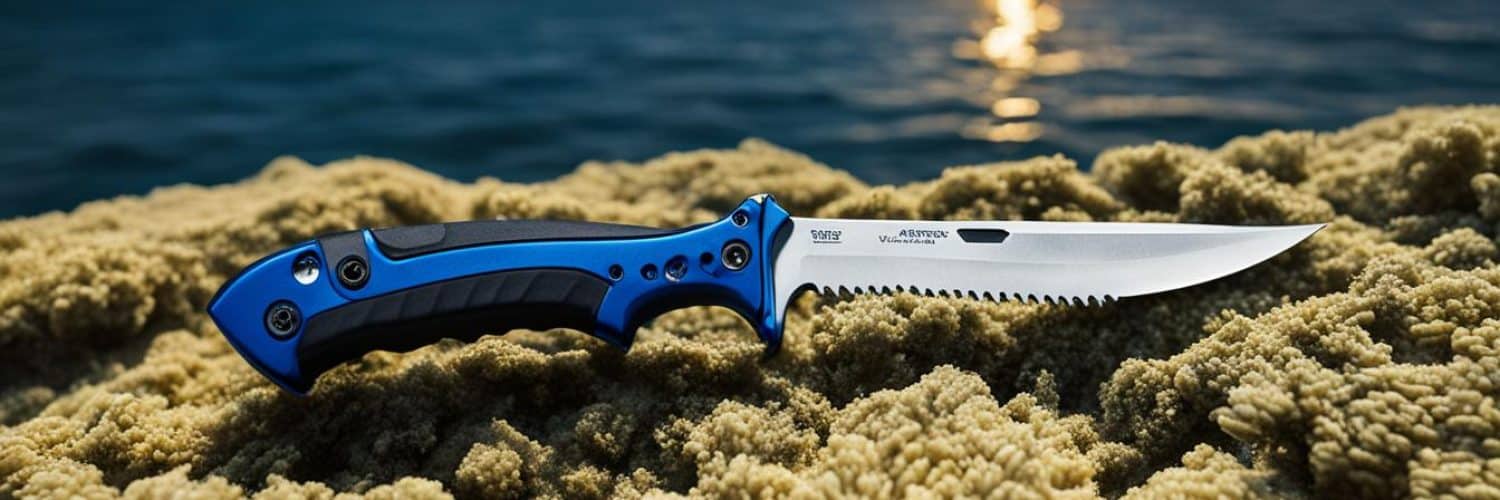When it comes to diving, having a reliable and efficient dive knife is essential for both safety and convenience. Whether it’s cutting through lines and nets or freeing yourself from entanglements, a high-quality dive knife can make all the difference in crucial moments underwater. In this article, we will explore the best dive knives on the market, providing you with the essential information to make an informed decision.
Key Takeaways:
- Choosing the right dive knife requires considering factors such as cutting ability, ergonomics, durability, and corrosion resistance.
- The Spyderco Salt 2 Green LC200N Wharncliffe knife is the top choice based on its excellent cutting ability, corrosion resistance, and comfortable grip.
- Other top dive knives, such as the Edge Quick Lock Assassin and Seac Blunt, also performed well in tests and offer different features and price points.
- When selecting a dive knife, consider factors like blade type, handle comfort, attachment methods, and maintenance requirements.
- Proper care and maintenance, including rinsing and drying the knife after each dive, are crucial for its longevity and performance.
Cutting Ability
One of the key factors in choosing a dive knife is its cutting ability. Divers often encounter various materials that need to be cut, such as heavy-duty plastic trimmer lines, polypropylene ropes, manila nets, and twisted polypropylene cords. To assess the effectiveness of dive knives in cutting through these materials, our team conducted rigorous tests.
Knives were evaluated based on their ability to cut these materials in one pass or with multiple passes. The Spyderco Salt 2 Green LC200N Wharncliffe knife, equipped with a high-performance LC200N stainless steel blade, excelled in this category. It effortlessly sliced through the test lines and maintained its sharp edge even after repetitive cuts. The cutting ability of the Spyderco Salt 2 Green LC200N Wharncliffe knife sets it apart as a top contender for divers in need of a reliable and efficient cutting tool.
The Spyderco Salt 2 Green LC200N Wharncliffe knife impressed our testers with its exceptional cutting ability and durability. It effortlessly sliced through various materials, demonstrating its reliability in real-life diving situations.
Whether you need to cut fishing lines, nets, or other materials, a dive knife with superior cutting ability is essential for safety and convenience underwater. The Spyderco Salt 2 Green LC200N Wharncliffe knife delivers on its promise of exceptional cutting performance, making it an excellent choice for divers looking for a trustworthy companion during their underwater adventures.
Ergonomics
When it comes to a dive knife, ergonomics play a crucial role in ensuring safety and ease of use. Testers evaluated the performance of the knives’ grips, sheaths, and locking mechanisms to determine their overall ergonomics. The Spyderco Salt 2 Green LC200N Wharncliffe knife showcased exceptional ergonomics, earning high scores in this category.
Grip
The grip of a dive knife is essential for maintaining control and precision during underwater tasks. Testers noted that the Spyderco Salt 2 Green LC200N Wharncliffe knife offers a comfortable grip that enables divers to hold the knife securely, even when wearing gloves. This ergonomic design allows for confident and fatigue-free cutting.
Sheath and Locking Mechanism
A well-designed sheath and a reliable locking mechanism are essential for the safe storage and deployment of a dive knife. The Spyderco Salt 2 Green LC200N Wharncliffe knife impressed testers with its rock-solid lock mechanism, ensuring that the blade remains secure during use. Additionally, the knife’s sheath allowed for easy removal and replacement, even with gloves on, enhancing convenience and accessibility.
With its superior ergonomics, including a comfortable grip, reliable sheath, and secure locking mechanism, the Spyderco Salt 2 Green LC200N Wharncliffe knife stands out as an excellent choice for divers seeking a dive knife that prioritizes comfort and ease of use.
**Note**: The image above showcases the ergonomic design of a dive knife, emphasizing the importance of a comfortable grip and easy accessibility.
Durability
One of the crucial aspects to consider when choosing a dive knife is its durability. A reliable dive knife should be able to withstand the demanding conditions of underwater environments without breaking or rusting. To assess the durability of the dive knives, our testing process included rigorous evaluations.
Pry Test:
During the pry test, we hung a weight from the handle of each knife to measure its strength and resistance to breaking. This test aimed to simulate real-world scenarios where divers might encounter situations requiring prying or leveraging actions. The Spyderco Salt 2 Green LC200N Wharncliffe knife successfully withstood the pressure, exhibiting exceptional durability and toughness.
Corrosion Resistance:
As saltwater is known to cause corrosion, we subjected the dive knives to an extended saltwater immersion test. Knives were submerged for prolonged periods and then inspected for any signs of rust or corrosion. The Spyderco Salt 2 Green LC200N Wharncliffe knife proved its superior resistance to rust and corrosion, showcasing remarkable durability even after being submerged in saltwater for 24 hours.
With its exceptional performance in both the pry test and the saltwater immersion test, the Spyderco Salt 2 Green LC200N Wharncliffe knife proves to be highly durable, ensuring reliability and longevity for divers in challenging underwater conditions.
| Dive Knife Model | Result of Pry Test | Result of Saltwater Immersion Test |
|---|---|---|
| Spyderco Salt 2 Green LC200N Wharncliffe knife | Passed | No signs of rust or corrosion after 24 hours |
| Other Tested Dive Knives | Varied | Results ranged from mild rusting to severe corrosion |
Other Top Dive Knives
In addition to the Spyderco Salt 2 Green LC200N Wharncliffe knife, several other top dive knives were tested and evaluated. These dive knives offer a range of features and performance to meet every diver’s needs. Let’s take a closer look at some of them:
Edge Quick Lock Assassin Knife
The Edge Quick Lock Assassin knife received positive feedback for its innovative squeeze-lock system, allowing for easy removal and replacement of the knife from the sheath. This feature ensures quick and convenient access to the dive knife in any situation. With its sleek design and durable construction, it is a reliable companion for underwater adventures.
Seac Blunt Knife
The Seac Blunt knife impressed testers with its smooth cutting edge and exceptional cutting scores. Its sharp blade effortlessly glides through various materials, making it a versatile tool for divers. This dive knife’s performance and reliability set it apart as a top choice for scuba diving enthusiasts.
Spyderco Salt 2 Green LC200N
The Spyderco Salt 2 Green LC200N knife, without the Wharncliffe blade, also attained high praise for its outstanding cutting performance and lightweight design. This dive knife boasts a corrosion-resistant blade and a comfortable grip, ensuring a secure and efficient cutting experience during underwater expeditions.
Cressi Kai
The Cressi Kai dive knife offers a durable construction with a sharp and reliable blade. Its ergonomic handle provides a comfortable grip, enhancing precision and control while underwater. With its versatile design and excellent cutting capabilities, the Cressi Kai is a popular choice among diving enthusiasts.
Edge Quick Lock Hunter
The Edge Quick Lock Hunter knife is another reliable option for divers. Its robust construction and ergonomic grip make it suitable for various diving activities. Equipped with a sharp blade and a secure locking mechanism, the Edge Quick Lock Hunter is a trusted companion for scuba divers.
HOG Pro BCD Knife
The HOG Pro BCD Knife is renowned for its durability and functionality. This dive knife features a strong and sharp blade, ideal for cutting through different materials. Its compact size allows for easy attachment and accessibility, making it a practical choice for divers.
These dive knives offer exceptional performance and reliability, making them top choices for scuba diving enthusiasts. Whether you’re looking for a knife with innovative features, smooth cutting edges, lightweight designs, or durable construction, there is a dive knife for sale that suits your needs.
Remember, when choosing a dive knife, consider factors such as cutting ability, durability, ergonomics, and corrosion resistance. Select a dive knife that meets your specific requirements and enhances your diving experience.
Features to Consider in a Dive Knife
When choosing a dive knife, it is important to consider its features. Dive knives come in various types and offer different functionalities to meet the specific needs of divers. Here are some key features to consider:
Blade Type:
Dive knives can have different types of blades, including sharp tips and blunt tips. Sharp tips are favored by the spearfishing community as they are ideal for puncturing and cutting tasks. On the other hand, blunt tips are better suited for digging, prying, and hacking underwater.
Line Cutting Notches:
Line cutting notches are a valuable feature found in many dive knives. These notches allow divers to quickly and easily cut through entangled lines in emergency situations, ensuring their safety and freedom of movement.
Handle Type:
The type of handle on a dive knife can greatly affect its comfort and grip. Look for knives with ergonomically designed handles that provide a secure hold, even when wearing gloves. Some handles are textured or feature rubberized inserts for enhanced grip in wet conditions.
Attachment Methods:
Consider how you would like to attach your dive knife. Leg-mounted knives are commonly secured to leg straps for easy accessibility. BCD-mounted knives can be attached to the diver’s buoyancy control device or air hoses, providing a convenient location for quick access. Foldable knives, on the other hand, can be compactly stored in a BCD pocket.
Blade Color:
The color of the blade may not seem like a crucial factor, but it can make a difference in underwater visibility. Choose a blade color that contrasts well with your diving environment to ensure easy identification and retrieval of your knife when needed.
Considering these features will help you choose a dive knife that best suits your diving style and needs. Now let’s take a closer look at some top dive knives and their specific features in the next section.
How to Attach Your Dive Knife
Attaching your dive knife correctly is crucial for easy accessibility and safety during your dives. Your choice of attachment method will depend on personal preference and convenience. Here are three common ways to attach your dive knife:
- Leg-Mounted Knife: Leg-mounted knives are popular among divers as they offer quick and easy access. These knives are typically attached to leg straps, allowing you to reach them effortlessly with either hand. The leg-mounted attachment is ideal for divers who prefer to have their knife close at hand at all times.
- BCD-Mounted Knife: If you prefer a more streamlined approach, you can attach your knife to your BCD (Buoyancy Control Device) or air hoses. Compact knives with a secure attachment mechanism can be easily mounted to the BCD or clipped onto the hoses. This option provides a clutter-free setup and keeps your knife within reach if needed.
- Foldable Knife: Some dive knives are designed to be foldable, allowing for easy storage in a BCD pocket or pouch. These knives usually have a compact design and a folding mechanism that ensures the blade is safely locked in place when not in use. Foldable knives are a great choice for divers who prioritize space-saving solutions and prefer to keep their knife protected when not needed.
Remember, regardless of the attachment method you choose, it is important to regularly clean and maintain your dive knife separately from the rest of your gear. This will help ensure its sharpness, functionality, and resistance to rust. Take the time to rinse your knife thoroughly with fresh water after each dive and allow it to dry naturally before storing it.
Other Considerations for Dive Knives
Proper care and maintenance are crucial for ensuring the longevity and optimal performance of your dive knife. By following the recommended care practices, you can maximize the lifespan of your knife and keep it in top condition for your underwater adventures.
Dive Knife Care:
After each dive, it is essential to rinse your dive knife thoroughly with fresh water. This helps to remove any salt or debris that may have accumulated during your dive. Make sure to pay close attention to the blade and handle, ensuring all nooks and crannies are free of residue. Allow the knife to dry naturally before storing it to prevent the growth of mold or mildew.
To prevent rusting and corrosion, it is advisable to apply a light coating of oil or grease to the blade. This protective layer acts as a barrier against moisture and saltwater, keeping the knife’s metal components in pristine condition. Regularly inspect the knife for any signs of rust or damage, and address any issues promptly to maintain its performance and longevity.
Dive Knife Materials:
When choosing a dive knife, it is important to consider the materials from which it is made. Dive knives are typically crafted from stainless steel, titanium, or ceramic, each with its own unique advantages and disadvantages.
Stainless steel knives are durable and resistant to corrosion, making them a popular choice among divers. They are relatively affordable and offer excellent cutting performance. However, stainless steel knives may require more frequent maintenance to prevent rusting.
Titanium knives are lightweight, extremely corrosion-resistant, and have excellent strength. They are ideal for divers who prioritize durability and performance. Although titanium knives tend to be more expensive than stainless steel options, their long-lasting quality justifies the investment.
Ceramic knives are lightweight, rust-resistant, and remain sharp for an extended period. They are less prone to corrosion compared to stainless steel knives, and their non-metallic composition makes them an attractive choice for divers concerned about the potential for metal detectors to flag their equipment.
Dive Knife Grip:
The grip of your dive knife is crucial for both safety and comfort while underwater. It should provide a secure hold, even when you’re wearing gloves or your hands are wet. Look for knives with ergonomic handles that offer a firm grip and reduce the chances of slippage.
Test the knife’s grip before making a purchase to ensure it fits comfortably in your hand. Consider the handle design, materials, and texture, as these factors can significantly impact your overall experience. A reliable grip ensures precise control and maneuverability when using the knife, enhancing safety during underwater activities.
By following proper care and maintenance practices, considering the materials used in your dive knife, and choosing a knife with a comfortable and secure grip, you can ensure a reliable and effective tool for your diving adventures.
Conclusion
After conducting thorough tests and evaluations, the Spyderco Salt 2 Green LC200N Wharncliffe knife has emerged as the best dive knife in the compact category. With its exceptional cutting ability, corrosion resistance, comfortable grip, and reliable locking mechanism, this knife impressed our testers across the board.
However, it’s important to note that other dive knives also performed well in our tests and offer a range of features and price points to cater to different divers’ needs. The Edge Quick Lock Assassin, Seac Blunt, and Mares Hand Line-cutter B Titanium are among the top performers in our evaluations, providing divers with excellent options to consider.
Ultimately, the best dive knife for you will depend on your personal preferences, budget, and intended use. Whether you prioritize cutting ability, ergonomics, durability, or other factors, it’s important to choose a dive knife that meets your specific requirements and enhances your diving experience. We hope our comprehensive evaluations and recommendations have helped you in making an informed decision when selecting the best dive knife for your diving adventures.
FAQ
What factors should I consider when choosing a dive knife?
When choosing a dive knife, it is important to consider its cutting ability, ergonomics, durability, and corrosion resistance. These factors will ensure that your dive knife is safe and functional underwater.
How was the cutting ability of dive knives tested?
The cutting ability of dive knives was tested by evaluating their performance in cutting through various materials commonly encountered by divers, such as heavy-duty plastic trimmer line, polypropylene, manila, and twisted polypropylene. Knives were scored based on their ability to cut these materials in one pass or with multiple passes.
What were the results of the cutting ability tests?
The Spyderco Salt 2 Green LC200N Wharncliffe knife scored exceptionally well in the cutting ability category, effortlessly slicing through the test lines and maintaining its edge even after repetitive cuts.
How were the ergonomics of dive knives evaluated?
Knives were evaluated for the performance of their grips, sheaths, and locking mechanisms. Testers assessed the security of the sheath or folding lock, ease of removing and replacing the knife from the sheath (with and without gloves), and the comfort and security of the grip while cutting.
Which dive knife received high scores in the ergonomics category?
The Spyderco Salt 2 Green LC200N Wharncliffe knife received high scores in the ergonomics category, with testers noting its rock-solid lock mechanism, comfortable grip, and ease of deployment with one hand.
How were the durability of dive knives tested?
Knives underwent a pry test where a weight was hung from the handle to gauge its strength. They were also submerged in saltwater for extended periods of time and inspected for corrosion to test their durability.
Which dive knife demonstrated exceptional durability in the tests?
The Spyderco Salt 2 Green LC200N Wharncliffe knife demonstrated exceptional durability, with no signs of rust or corrosion even after being submerged in saltwater for 24 hours.
Are there any other top dive knives that were tested?
Yes, in addition to the Spyderco Salt 2 Green LC200N Wharncliffe knife, other top dive knives were tested and evaluated. These include the Edge Quick Lock Assassin knife, Seac Blunt knife, Spyderco Salt 2 Green LC200N knife, Cressi Kai, EDGE Quick Lock Hunter, and HOG Pro BCD Knife.
What features should I consider in a dive knife?
When choosing a dive knife, it is important to consider the type of blade (sharp or blunt tip), line cutting notches, type of handle, attachment methods (leg-mounted, BCD-mounted, or foldable), and the color of the blade.
How should I attach my dive knife?
Dive knives can be attached to different parts of your diving gear, depending on personal preference and convenience. Leg-mounted knives are typically attached to leg straps, while compact knives can be attached to the BCD or air hoses. Some knives are designed to be foldable and can be stored in a BCD pocket.
How should I care for and maintain my dive knife?
Proper care and maintenance of dive knives are essential for their longevity and performance. It is recommended to rinse the knife thoroughly after each dive and allow it to dry naturally. Applying a light coating of oil or grease to the blade can help prevent rusting. Additionally, the knife should be manually cleaned and maintained separately from the rest of your gear.
Which dive knife emerged as the top choice?
After extensive testing and evaluation, the Spyderco Salt 2 Green LC200N Wharncliffe knife emerged as the top choice for a compact dive knife. Its exceptional cutting ability, corrosion resistance, comfortable grip, and reliable locking mechanism impressed the testers. However, other dive knives, such as the Edge Quick Lock Assassin, Seac Blunt, and Mares Hand Line-cutter B Titanium, also performed well in the tests and offer various features and price points to suit different divers’ needs.







Add comment